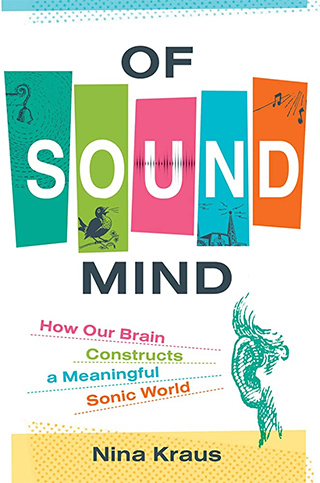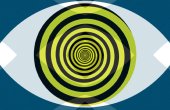The Extraordinary Ways Rhythm Shapes Our Lives

My husband reads to me every night in bed before we go to sleep. With our special bear, Oatmeal, tucked in between us and listening too, this is a wonderful way to end the day and is a quotidian highlight. We deliberately choose books that are familiar — oft-read children’s classics by E. B. White and the Harry Potter series make frequent appearances — so I do not worry about missing something important when I drift off. I have noticed that after some time — it can be as little as a few minutes if I am especially tired — the meanings of the words are gradually eclipsed by the sounds. I begin to hear sounds and rhythms instead of words and story, and the waxing and waning of the accents and stress patterns become a calming, lulling, treasured experience that soothes and resets me after a long day.
Why do we care about rhythm? It connects us to the world. It plays a role in listening, in language, in understanding speech in noisy places, in walking, and even in our feelings toward one another.

Rhythm is much more than a component of music. Nevertheless, music is probably what first comes to mind when we hear the word rhythm: drumming, jazz, rock and roll, marching bands, street performers with wooden spoons and five-gallon buckets, drum circles, time signatures, stomp-stomp-clap — we will, we will rock you — adventures on the dance floor, beatboxing, incantations, mantras, and prayers. Beyond music, we experience the rhythmic changes of the seasons. Some of us have menstrual cycles. We have circadian rhythms — daily cycles of mental and physical peaks and troughs. Frogs croak rhythmically to attract mates and change their rhythm to signal aggression. Tides, 17-year cicadas, lunar phases, perigees, and apogees are other naturally occurring rhythms. Human-made rhythms include the built world — street grids, traffic lights, crop fields, mowed designs in baseball diamond outfields, the backsplash behind the kitchen counter, spatial patterns in geometric visual artforms.
Maintaining rhythm is almost a biological imperative for some of us. My musician husband can get infuriated if we are playing together and I stop in the middle of a song. He needs to keep the pulse going. I have my own hiking version of this imperative. I need to keep moving no matter how tired I get, one foot in front of the other, even if I slow way down, or essential energy just drains away.
Rhythms in the brain have been called out as a basis for consciousness itself.
Music and rhythm are rooted in every known culture. What parent does not use rhythmic rocking to soothe a crying baby? The repetitive sounds and silences that comprise rhythmic patterns make dancing possible, aid in the memory and reproduction of music, and facilitate group singing, playing, or drumming. Rhythm has been used for millennia to tie societal members together — the chants of a religious order or the cadence calls of military ranks are just two examples. Poetic works thousands of years ago, such as those of Homer, were chanted or sung with rhythm serving a mnemonic function. Repetitive or complex work engenders rhythmic accompaniment, in some cases to break the monotony, in others to actually help you perform the work better. Workers performing hard labor like rock breaking chant to keep their sledgehammers swinging in rhythm. Postal workers in Ghana hand-cancel stamps with a distinct rhythm. Rug weavers in Iran use chants with a complex musical structure to communicate weaving patterns to their co-weavers. All musical systems and styles have organizational rhythmic motifs. Indeed, the very universality of rhythm is a strong argument for the existence of biological processes governing the perception and production of rhythm. Rhythms in the brain have been called out as a basis for consciousness itself.
Language probably does not immediately come to mind when we think of rhythm. You might have had a high school literature class where you learned about prosodic feet — iambs, trochees, and anapests. But outside the context of poetry, we rarely think about speech having a particular rhythm. After all, we are likely to say “Oy Bill — you ready yet?” Not, “Hey there Bill,/do you think/it is now/time to go?” so that it conforms to dactylic tetrameter. What about rhythm and reading? Here, too, we are unlikely to associate rhythm to reading unless we are reading poetry. In fact, rhythm is a necessary ingredient of linguistic communication itself.
Rhythms Fast and Slow
Rhythm can be viewed through the lens of shorter and longer time scales. Speech has phoneme-, syllable-, word-, and sentence-length rhythmic units, each unfolding at their own rate. We understand that speech comes in different sized units — the sound an individual letter makes, the phoneme, at one extreme, and the slowly rising and falling loudness and pitch contours that unfold over the course of a sentence or group of thoughts on the other. This latter one is the nighttime reading rhythm I fall asleep to. These entwined elements of speech constitute rhythms that must be sorted by our sound minds. We can try to focus on the slow parts of speech (say, the fluctuating pitch of the voice) and ignore the fast (the vowel and consonant sounds that convey the meaning of the words) or vice versa. But this is usually not possible and rarely desirable.
This temporal hierarchy is at work in music too. Music is a mix of slow phrases, steady beats, sustained notes, rapidly changing notes, trills, and drum crashes. Entwined temporal structures are in environmental sounds as well — when walking through the woods, we simultaneously hear slow footsteps, the unfolding crunch of leaves underfoot, and the rapid snap of a twig. Much as sound units come in different lengths, brain rhythms come in different speeds. Subcortical structures are equipped for microsecond timing while the cortex is better suited to integrating sounds over a longer time scale.

Brain rhythms can be measured both when at rest and when performing an activity. When listening to speech, there are fast brain rhythms that entrain to the fast phonemes, the near instantaneous consonant sounds. Middle-range rhythms in the brain track the rate of syllables. Slower brain rhythms correspond to the slow oscillations of phrases and sentences. Similar nested brain patterns are active when listening to music.
Rhythm is in Us
We’ve all heard him. The beginning piano player. The “Eensie Weensie Spider” and “Frère Jacques” plinking hesitantly out of the piano. Usually getting the notes right is paramount to a beginner; hitting the right keys trumps hitting them at the right time. It is heartwarming to listen as our child plays (mostly) correct notes at wildly incorrect times. What goes on in the brain when we hear music being played on beat or off beat?
Imagine a metronome ticking at about 144 beats per minute (bpm). Popular songs in this range include Blondie’s “Call Me,” the Beatles’ “Back in the USSR,” and the Rolling Stones’ “(I Can’t Get No) Satisfaction.” It’s a fast, allegro rate. Measured another way, these songs have about a half second between their beats. If we play a conga drum by itself at this rate and record brain waves to it, we will see neural activity repeating every half second (boom, boom, boom, boom, or “one, two, three, four”). But what does the brain do if you listen to the conga drumming along to a song that matches this beat? The brain produces a new rhythm! In addition to a response peak every half second (where musically speaking the “ones” are), you see another, smaller peak halfway in between (1 and 2 and 3 and 4 and; “FLEW in FROM mi-AM- i BEACH”). The brain has worked out the strong/weak pairs comprising the song’s meter.
If our rhythmic expectations are violated, our brains behave in a different manner because of our inherent internal sense of rhythm.
This tells us the brain entrains and reinforces both explicit and implied rhythms in the music. This extra rhythm in the brain wave does not occur when the song is deliberately misaligned with the conga beat. A similar example of the brain creating a beat comes from Brainvolts alum Kimi Lee, who found that the fundamental frequency of an identical speech sound is enhanced when it occurs on the “1” in a four-beat sequence. The sound mind’s response to a drumbeat is deeply shaped by its aural context. Rhythmic organization operates automatically when we listen to sound. If our rhythmic expectations are violated, our brains behave in a different manner because of our inherent internal sense of rhythm.
Rhythm Intelligences
Imagine the familiar rhythm “Shave and a haircut, two bits” and tap it out on a table with your finger. Did you tap seven times? Now imagine it again and tap your foot to it. Did you tap seven times again? Or fewer? For me, when I tap my finger on a table, I tap to every note (ignoring the rests). When I tap my foot or snap my finger along to music, I typically tap or snap to the beat (or pulse) of the song, not every note. When I tap my finger on the table, hitting the “sounds” and ignoring the “silences,” I am tapping out the rhythmic pattern — I am keeping track of how long or short each note is and where the pauses occur. When I tap my foot, I tap four times, to the underlying beat or pulse (see the rhythm pattern below), which in this example includes a silent beat. Music has both a pulse and a rhythm pattern, notated by time signature and note/rest durations, respectively.

Before I began studying rhythm, if you had asked me about the skills involved in tapping out rhythmic patterns versus tapping out the beat, I would have said, “You’re probably either good at both or not so good at either.” If someone can tap to a beat, she can also tap out a rhythm pattern, right?
Wrong. There are multiple rhythmic intelligences. You cannot predict how someone will perform one rhythm task by how they perform a different rhythm task. This was first noticed in extreme cases where a person with brain damage could be impaired in one sort of rhythmic ability but not another. We have since learned these distinctions are fundamental to how the system works: we see dissociations between rhythm skills in all of us, confirming the idea that “rhythm” is not an all-or-nothing ability, and more intriguingly, our proficiency executing one type of rhythm or another bears on our language skills. Both beat-keeping and rhythm-pattern skills predict language development and reading ability; however, only rhythm-pattern ability has a bearing on understanding speech in noise, as we will see in a moment.
Brain Rhythms
Rhythm pattern skills are associated with slower brain rhythms (seconds), while beat-keeping skills are associated with faster brain rhythms (milliseconds and microseconds). Phonemes, syllables, and sentences range from microsecond to millisecond to second timing, respectively. Brain rhythms can predict language development in infants and children. Brain rhythms can also determine a person’s strengths and bottlenecks related to language and the ability to make sense of an auditory scene while listening in noise.
Rhythm, Language, and Listening
Rhythm is tied to language. Children who recognize differences in rhythm patterns and tap to a beat learn to read and spell more easily. Several beat-keeping skills are impaired in older children with dyslexia. We have found a link between beat keeping and language development in adolescents and in children as young as three years old. What is the connection between rhythm skills and what might appear to be unrelated skills like reading and writing?
There really is rhythm in language, beyond the rhyming of poetry. It is inherently a part of pronunciation. Rhythm matters, even in single words. “Record,” “contrast,” “project,” and “produce” can be either nouns or verbs depending on which syllable is stressed. Running speech also has rhythm. A YouTube search for “drumming to speech” will uncover some nice examples; a personal favorite is the one with the scene from the Gene Wilder Willy Wonka movie. The video shows a drummer playing along to the rhythms of the dialogue between Willy and Grandpa Joe, so you cannot miss the rhythm in speech. Tabla player Zakir Hussain tells us his father taught him to speak using drum rhythms when he was a baby. In tabla, each finger is assigned a syllable, and playing the tabla is akin to speaking in phrases. In all languages there is a definite rhythmic aspect to spoken language, brought about by alterations in stress, duration, and pitch of the syllables. This was resoundingly brought home to me firsthand when Zakir accompanied me on the congas during a speech on rhythm and language.
Children who recognize differences in rhythm patterns and tap to a beat learn to read and spell more easily.
Quite simply, rhythm in speech tells us when important information starts and stops. Stressed syllables emerge at roughly regular intervals and, importantly, carry the majority of the information of speech. With an ongoing rhythmic flow, the listener is guided to the important features of the sentence by the expectancy rhythm sets up and, so primed, we understand the content of the spoken word better. With the understanding of spoken speech comes the ability, when learning to read, to make the necessary connections between the sounds of language and its written form.
One of the greatest impediments to successful spoken-word communication is noise. The rhythm of speech helps us. This is because the rhythm in speech helps us fill in the gaps when noise causes us to miss a few words. Just as a rhythm pattern evolves over the course of a measure of music, running speech evolves over time and thus is suited for a slower scale of auditory processing. The strong and weak stresses, phrases, and boundaries of language are relevant to the whole spoken sequence. The ability to reproduce rhythm patterns seems to draw on the same skills required for forming the auditory scenes that comprise hearing speech that is barely audible above noise.
Hearing speech in noise can be partly predicted by one’s ability to tap out rhythm patterns. And the better you are at navigating rhythms — and musicians of any stripe (not just drummers) fall into this category — the more you can capitalize on the rhythmic patterns in speech and eke out what was said despite the noise.
Rhythm and Socialization
How we feel about another person is conveyed by rhythm. Walkers synchronize their steps to aid communication. Snowball the cockatoo will dance along with you, but if you dance out of sync with the beat, he will turn away from you. Social encounters with rhythm influence our attitudes. The extent to which a person synchronizes with an experimenter affects the person’s opinion of the likability of the experimenter. University students were instructed to tap along to a metronome while an experimenter was also tapping their finger nearby. When the experimenter tapped at the same rate, the rating given in response to “how likable was the experimenter?” was higher. Likability aside, the mere presence of another person drumming along with a task will improve performance. Pre-school-age children asked to perform a rhythm synchronization task perform it better if they are drumming along with another human than to an impersonal beat coming from a loudspeaker.
Even in very young children, being (literally) “in sync” with another person engenders positive feelings toward them. In one study, an experimenter bounced 14-month-old children along to music either on the beat or intentionally off the beat. When the bouncing session was over, the baby was placed on the floor and the experimenter deliberately dropped an object and acted out needing help to pick it up. The babies who were bounced on-beat were much more likely to help the experimenter retrieve the object, having apparently formed a social bond, via rhythm, that prompted cooperation. The off-beat babies were less likely to help. Rhythmic synchrony had led to interpersonal synchrony.
Even in very young children, being (literally) “in sync” with another person engenders positive feelings toward them.
Along similar lines, the brain rhythms of musical performers and their audiences have been measured in concert settings. The brain rhythms tend to synchronize, and the more synchronization between performer and listener, the more listeners report enjoying the performance.
Music in general, and rhythm in particular, does an uncommonly good job fostering a sense of community. Indeed, music being played at negotiation sessions helps to smooth the conversations and leads to breakthroughs and compromises. Musicians Without Borders is used to form relationships in troubled regions around the world, to bring hope, comfort, and healing to diverse populations. The Resonance Project and the Jerusalem Youth Chorus, which are forming bonds between Israeli and Palestinian children, are other examples of using musical rhythm to overcome differences. The early days of the 2020 coronavirus pandemic were marked, in some European countries, by daily sessions of songs sung from balconies to connect with others at a time of isolation and to communicate appreciation and solidarity with health-care workers.
Rhythm for Health
Traditional healers in all regions of the world have relied on rhythm as a primary force in their rituals and practice. Today, rhythm helps us exercise as we move to keep ourselves healthy. Therapists have long used our capacity to perceive sound patterns to strengthen communication skills. They rely on rhythm and the concepts of entrainment to a beat, violations of a beat, and pattern recognition as core features of their protocols, reminiscent of the scene in the Colin Firth film “The King’s Speech,” where King George VI overcame a stuttering problem by rhythmically singing his words. Rhythm capitalizes on our sound minds’ auditory-motor connection.
First mentioned by the American Medical Association in 1914, music therapy was put to work helping wounded World War I soldiers recover from their injuries, including what we now call traumatic brain injury. Rhythm-based therapy has a growing status in recovery from concussion and other brain injuries, addressing both cognitive and emotional health. Rhythm is used to great effect to pace walking in individuals with movement disorders such as Parkinson’s disease, for example. After all, walking is a rhythm. Numerous studies have found that other disorders that involve movement, such as aphasia, stuttering, difficulty with respiration, swallowing, and speaking, respond to music therapy.
Therapy involving rhythm also has shown promise in addressing communication and social behavior in people on the autism spectrum. Children who cannot otherwise speak can form words and sentences when accompanied by a clear rhythm. There are children on the autism spectrum who will not engage in a verbal conversation but will gladly carry on a rhythmic conversation with another person on drums.
If I had a magic wand, I would make rhythm an indisputable part of language therapies through music and rhythm-based instruction. This would mean a closer alignment among fields of speech therapy, music, and music therapy. There are explicit rhythm-based training programs which make synchronizing to rhythm an explicit core exercise with the aim of improving timing in the brain. Some have been used to bolster language, reading, and communication skills, and do so with tasks that engage both the slow and fast sound processing circuits in the brain, thus drawing on multiple rhythm intelligences.
Music with a regular and predictable rhythm can lead to states of enjoyment or emotional transcendence. Pythagoras viewed music as a gateway to the realm of the dead, at least judging from his supposed dying request that the monochord, an ancient one-stringed instrument, be played during his final moments. The music historian Ted Gioia has described Gregorian chants as “so rich in overtones that you have the impression they are angels, not men.” Grateful Dead drummer Mickey Hart and I have discussed the calm yet alert and energized state that drone compositions — musical pieces consisting of sustained sounds produced by monochords or other instruments and manipulated in the studio to swell and build — can induce. We are working together to investigate the neurophysiological reaction to some of his drone compositions.
A while back, one of my sons got a hairline fracture in his foot. As he was not healing as fast as his physical therapist was hoping, he was assigned daily sessions with a bone vibrator. The idea behind vibration therapy is that if you cannot use your musculoskeletal system normally, for example due to an injury or osteoporosis, you miss out on the natural stimulation that occurs as your muscles imperceptibly relax and contract to maintain posture. This can lead to bone tissue atrophy. Imposing vibrations at around 30–50 Hz at the injury site simulates natural postural adjustments, stops the reabsorption of bone tissue, and promotes the bone growth that would ordinarily be achieved as part of typical day-to-day movement. It appears that low frequency vibrations spur activity in the stem cells that make cartilage, muscles, and bones. This process may also be useful for strength training in noninjured people.
It turns out the vibration rate of a cat purr is in the exact same range as used in vibration therapy for bone growth. Cats purr when they’re happy, of course, but in what other circumstance do they purr? When they are injured! There is a hypothesis that cats purr as a mechanism to keep their bones and muscles stimulated and healthy and to restore their health when injured. Maybe it is not a coincidence that cats have better bone health and a lower incidence of osteoporosis than dogs. Maybe this is the secret to their nine lives.
The currency of the nervous system — electricity — is nothing if not rhythmic. The better we understand the biological basis of rhythm, the better we will be able to employ rhythm — in all its guises — to improve communication and to better understand ourselves.
Nina Kraus, a neuroscientist who has done pathbreaking research on sound and hearing for more than 30 years, is Hugh Knowles Professor of Neurobiology, Communication Sciences, and Otolaryngology at Northwestern University. She is the author of “Of Sound Mind: How Our Brain Constructs a Meaningful Sonic World,” from which this article is adapted.



